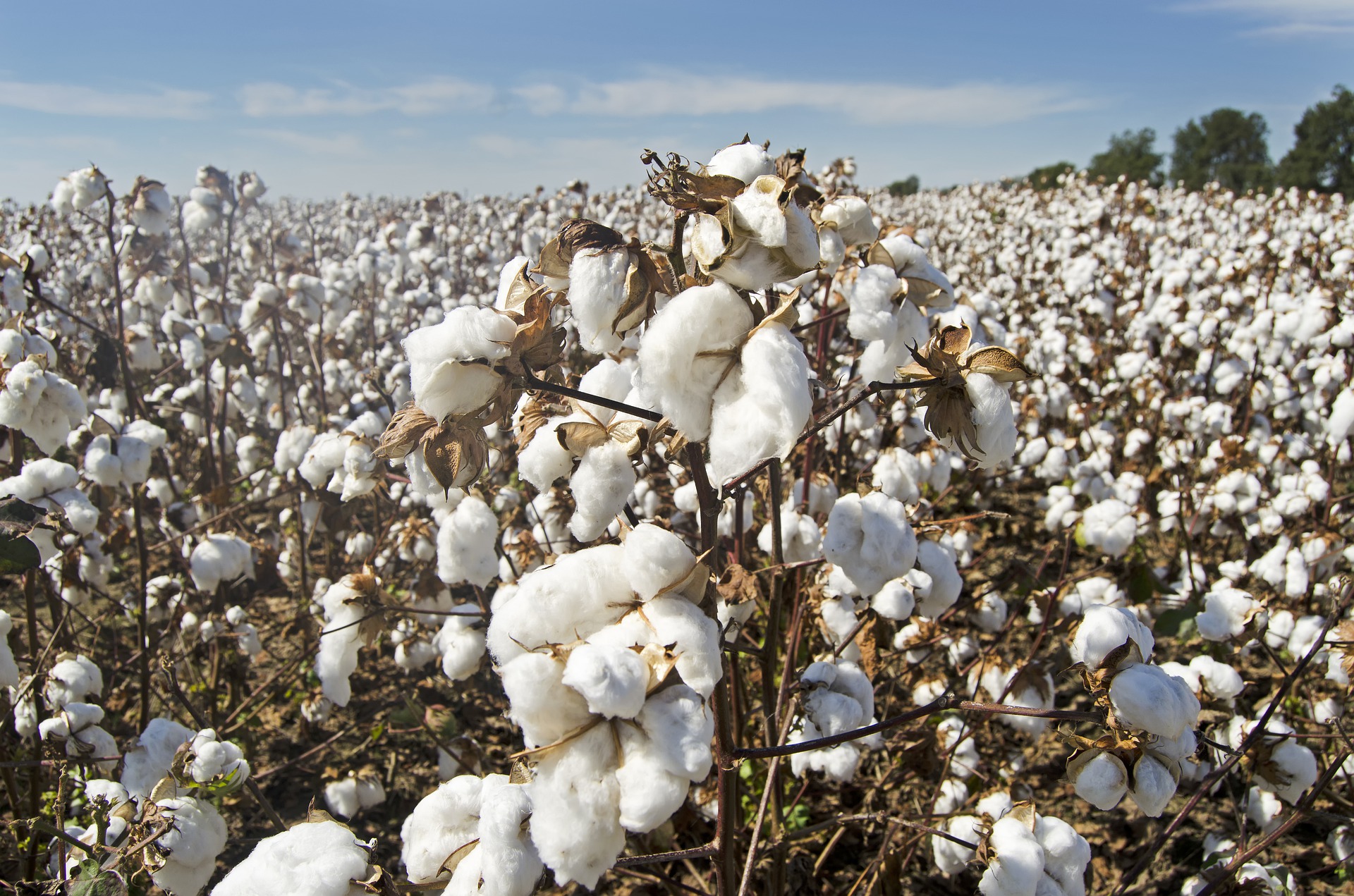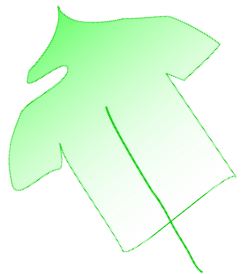Cotton fabric: farming, manufacturing, consumption and ethical considerations

Cotton is probably the most frequently used fabric in the world throughout history, at least that is the one fabric I come around the most. Cotton is made of natural fiber produced from cotton plants, from a fluffy protective boll situated around plant's seeds. Cotton fabric is soft, beautiful, comfortable and very practical one to use.
Farming and manufacturing processes
Cotton plants are growing in countries with warm climate. Seeds are planted in a plowed field and grown by common agricultural processes. During summer months (in Northern hemisphere), when the flowers in the field become matured enough they are harvested by cotton pickers along with plant's seeds and some small amount of leaves and straws.
Stems, leaves and seeds, along with some debris get cleaned out from cotton fibers. The seeds can be used to feed livestock, particularly cattle, as they are very nutritious, or to be used for plant oil production for some sauces preparation, for example mayonnaise.
White fluffy cotton fibers, now separated from all other components, are used in fabric production. It is worth noting that cotton agriculture requires large amounts of water and land.
Vast majority of the manufacturing processes are automated since the industrial revolution. After harvested produce delivery to cotton processing plant and harvesting byproducts removal, manufacturing process involves moisture evaporation, fiber sorting and pressing to bales.
Each bale is sampled, analyzed and graded by their quality, depending of features like fiber strength, elasticity, length, etc. Later bales are shipped to textile mills, where fibers get cleaned and straightened into a cotton yarns, which then woven or knitted into a fabric. Fabric gets dyed in various colors and sometimes printed if requested by the customer.
Based on bales fiber quality, resulted fabric is designates for different usage. Lower quality material could be used for manufacturing of average bed sheets, jeans fabric and other cost effective products, while higher quality fibers are used for more expensive products.
Either way, all types of cotton fabrics are very affordable and comfortable materials, characterized by their softness and breathability.
Cotton production and consumption statistics
Cotton fiber market share is almost 25 percent of global annual fiber production in the world. Three of the world's biggest cotton producing counties are: China, India and USA. Combined those three are responsible for more then 60 percent of yearly cotton production in the world.
World's leaders in raw cotton consumption are China, India and Pakistan. Those counties' consumptions have been growing and are expected to increase even more in near future. United States and Europe are leading in retail cotton consumption, although Asian countries, especially China and India, are closing the gap as a demand for clothing in that region is growing.
Cotton is used for just about everything around us. In fact, if you'll look around you right now, I bet you will see a lot of it too. Cotton most common end-usage is in clothing and other household uses, but also medical supplies and industrial usage of cotton are quit frequent.
Cotton fibers account for about one third of apparel fiber textiles, by far the most used among all natural fibers. To name only some of the cotton uses by humankind, there is of course all types of clothing - from underwear, to T-shirts, jeans, coats and shoes; home furnishings - from bed sheets, towels and curtains, to carpets and furniture;
various industrial products, like tampaulins, tents, ropes, book binding, paper money, high quality paper and canvas, coffee filters and even in astronaut's suits; and last but not least - a medical supplies like bandages and protective face masks.
In addition, cotton fiber is used very frequently in other blended fabrics as well as of coarse pure cotton fabric itself.
Statistically speaking, cotton fabric relative usage is decreasing as natural fibers in general are slowly loosing their lead to synthetic or blended materials. Most common substitute for cotton is polyester, which has it's advantages over natural material such as cotton, especially in terms of environmental footprint (plant farming consumes substantial amounts of water) and insensitivity to climatic factors.
Although it should be noted that synthetic textiles are still a long way behind cotton at their "feel" on the body, as well as general comfort of the textile.
Pest control in cotton farming
Unfortunately, during agricultural process of growing the plant some insects are "harmful" to it's optimal development, that's why farmers are using pesticides.
Other methods are also employed, like genetic engineering of the plant's breed with attributes of being less sensitive and less attractive to some insects and decrease their reproduction and multiplication in plant's surroundings. We would definitely consider those tactics to be more humane as they decrease overall suffering of living creatures relatively to pesticides, although they're far from being perfect.
Sometimes organic cotton farming is employed. Those methods do not allow any genetic engineering in it's conventional sense and aren't permitted to use chemical pesticides of any kind even though other pest control methods are employed. Those methods seem to cause less suffering then conventional pest control as well in addition to being more environmentally friendly. (Disclaimer: underlying goal of this site is to promote suffering reduction in our world, both human, animal, of insect and any other suffering able creatures, that is in addition to explanation and quick summary of discussed topics).
Cotton fabric recycling
Used cotton products can be recycled, but only a limited amount of times. Current technology only allows to use about 20 to 30 % of recycled cotton in a fabric, in which it should be mixed with virgin cotton or another material in blended textiles.
Recycling process begins with fabric and/or products collection and delivery to cotton recycling plant. There fabric first gets sorted by color, then sorted fabric groups are cut separately to small pieces and then those pieces are shredded further to individual fibers in several stages. Resulting fibers are shorter and characterized by lower strength then their virgin stage. Next stage is to combine those fibers with other material to knit or weave a new fabric. It can be done with a virgin cotton fibers or with other types of materials, like recycled plastic to produce blended fabrics.
Even though there is one process for recycling, the outcome in terms of resulting fibers quality is a bit different for textile recycled before reaching the end consumer and one that has already been used. That is largely because pre-consumer fabrics and products usually arriving in recycling facilities as more uniform bunch when it comes to their color and original fiber types, while post consumer items tend to vary a lot as they are usually collected from large variety of consumers.
Anyhow, recycling allows us to reduce the amount of unneeded waste creation, as well as lowering unneeded consumption of new textile products and prolongation of existing items utilization can do.
According to existing statistics, it is estimated that only about 15% of all household textile waste created in US is recycled.
Fortunately, cotton is biodegradable material, therefore cotton waste is not as much of a problem as it could be otherwise. Still, we as a society need to be doing much more to reduce cotton waste.
Workforce treatment
There is more than one major ethical issues accompanying cotton industry, one of the more severe ones is the way some workers has been treated by their employers. Probably the most commonly known historical ethical issue with cotton production has to do with history of slavery in America, where most of the slaves were employed in cotton fields. Unfortunately, related issues are still taking place around the world and modern day slavery, along with forced labor, are not uncommon.
The industry has to deal with allegations of child labor, poverty wages, overwork and over exhaustion of the employees and other issues with unethical human treatment.
Cotton over-consumption and prolongation of existing items utilization time
Cotton can easily become an "ethical" material, depending on the manufacturers - both agricultural and textile producers. We, as a consumers, can make a difference too by taking an interest in ethics of all stages of manufacturing processes and make our purchasing choices accordingly.
We encourage you to use recycled products when applicable and possible - they may actually be cheaper and more environmentally friendly, although probably little less comfortable. And of coarse it is beneficial to produce as little waste as possible, so please take a look on our article on life prolongation of your existing textile pieces, by means of laundry optimization and sewing tips link, try not to over-consume when you can and recycle the unusable items instead of throwing them away.
